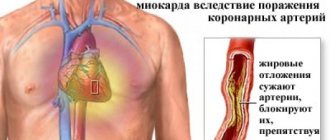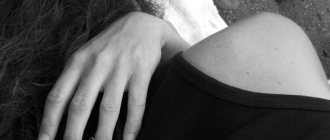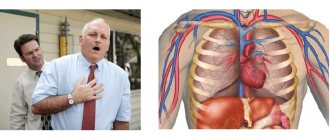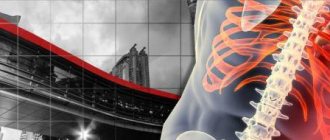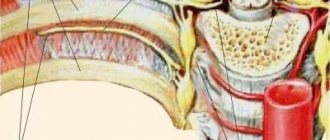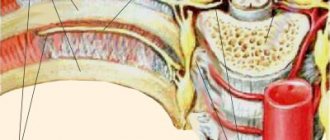Chest organs
To understand what exactly causes pain in the chest, localized in the middle, you should know that between the lungs, in the mediastinum, the most important organs of our body are concentrated:
- heart and great vessels (aorta, vena cava);
- bronchi, trachea;
- esophagus;
- The lymph nodes;
- muscles, ligaments, nerves.
Nearby is the diaphragm, abdominal organs, chest wall, thymus gland - they can also cause discomfort, such pain is called referred pain.
Despite the large number of important anatomical formations, all pain that occurs in the chest directly behind the sternum is in one way or another associated with one organ - the heart.
Irradiation of pain to the left shoulder, arms, neck, jaw - may be manifestations of pathological changes in other organs and tissues, but painful discomfort of any nature, intensity, arising in the center of the sternum reliably indicates the involvement of the heart.
What can hurt your chest?
To understand why the chest hurts when you inhale, you will have to remember the anatomical structure and location of the organs in this part of the body. In the thoracic region are located:
- the heart located in the cardiac sac; pericardium;
- thoracic spinal column;
- trachea, branching in the lower part into bronchi;
- aorta; the largest artery of the human body;
- lungs covered with pleura - a protective film that softens their friction against the costal arches.
In the lungs themselves there are bronchi and bronchioles, which are supplied with nerve cells, as well as the pleura and all the organs listed above. Any pathologies in the thoracic organs; pleura, trachea, heart or pericardium, accompanied by inflammation or irritation of pain receptors, can cause chest pain on inspiration. In addition, colic from an inflamed gallbladder or from the stomach or duodenum, covered by an ulcerative process, can radiate (spread) into it.
As you can see, there is a lot of pain in the chest and each case should be dealt with separately.
Finally, for various reasons, the intercostal muscles may hurt from excessive stress (for example, pain during intense training or due to prolonged coughing) or the ribs themselves, if they have been injured.
Causes of chest discomfort
Any sensation of pain is always a reaction of nerve endings to their compression. The reason for this situation may be:
- cough due to laryngotracheitis or pneumonia;
- pain when sighing indicates bronchitis, pericarditis, possible rib injury, stomach ulcer;
- discomfort in the chest when moving accompanies a heart attack or intercostal neuralgia;
- severe discomfort behind the sternum is characteristic of cardiac neurosis, aortic dissection;
- pain when pressing in the sternum area may indicate injury or muscle strain;
- aching retrosternal discomfort is a sign of atrial fibrillation or oncology.
The variety of manifestations forces us to focus on the nature of the pain; it is different for different diseases.
Pathology of the heart and blood vessels
Its symptom is a dull ischemic pain in the chest right in the middle. It occurs in 95% of cases, more often in men.
The distinctive features of the three main cardiac pathologies are presented in the table.
| Disease | Signs |
| Angina pectoris | A feeling of fullness in the chest, reflected pain for 3-15 minutes with irradiation to the left arm, under the shoulder blade, goes away on its own after rest |
| Acute myocardial infarction (AMI) | Diffuse soreness with stabbing sensations in the middle of the chest, does not disappear at rest, tends to increase, a panicky feeling of “animal” fear, profuse cold sweat |
| Pulmonary embolism (PE) | Inability to breathe due to pulmonary thrombus |
Typically, such a clinical picture is sufficient to make a preliminary diagnosis, which must be clarified by laboratory and instrumental examination.
Osteochondrosis
Simulates cardiac symptoms of osteochondrosis (5%). A distinctive point is that pressing retrosternal discomfort depends on the position of the patient’s body (an attack or a constant symptom), decreases with a horizontal position, and increases with walking.
In addition, intercostal neuralgia can cause pain behind the sternum: compression of the nerve endings generates cutting colic with pulsation, intense pain, and complete resistance to cardiac medications. Spinal diseases do not have gender differences; they occur equally often in men and women who break their diet and lead a sedentary lifestyle.
Digestive system problems
The digestive system may produce symptomatic soreness behind the sternum. The type of pain is very different.
| Disease | Characteristics of pain syndrome |
| Spasm of the hollow organs of the food tube: esophagus, gallbladder, stomach | Aching pain, aggravated by palpation of the epigastrium, radiating to the back |
| Acute pancreatitis | Burning pain in the sternum before and after meals, relieved with antispasmodics |
| Esophagitis | Heartburn, belching, lump in throat with minor chest discomfort |
| YABZH | Heart-like pain localized in the center of the sternum, but appears a couple of hours after eating and disappears if you eat something |
| Abscess of the diaphragm | Painful sensations when coughing with high fever |
| Gastroesophageal reflux | Characterized by burning discomfort in the chest with constant nausea |
Men who abuse bad habits and eat at any time convenient for them suffer from such diseases more often.
Respiratory system diseases
This pathology has one distinctive feature - cough. Therefore, any retrosternal discomfort accompanied by shortness of breath, cough reflex, sneezing indicates diseases of the bronchopulmonary tree. Additional signs can be considered:
- bluish skin;
- shortness of breath;
- hyperthermia;
- heart rhythm disturbance.
More often such manifestations appear in people who smoke.
Substernal pain in men
It turns out that the chest hurts differently in men and women. Physical activity is the main cause of such troubles for the stronger half of humanity. The mechanism of pain development is simple: hypereffort creates ischemia, which disrupts nutrition and oxygen supply to the main internal organs and tissues. Occurs:
- heart failure with stabbing pain in the chest;
- scoliosis with constant aching retrosternal discomfort;
- diaphragmatic hernia, manifested by severe pain in a horizontal and sitting position, but disappearing if the person stands upright;
- hypertension with shortness of breath, dizziness, lightheadedness, fainting;
- arthralgia of different localization with irradiation to the chest area;
- fractured rib with cutting pain.
In addition, heavy smokers develop persistent pain due to pathological nicotine cough. The causes of chest pain can be associated with bruises, falls, boxing, wrestling, and weightlifting. One way or another, the cause of the pain must be established.
Pancreatitis
This is a disease in which acute or chronic inflammation of the pancreas develops and the death of its cells occurs due to self-digestion. Pathology occurs at any age. Pain during the disease first occurs and presses in the stomach area. Then it quickly spreads, acquiring a girdling character and reverberating in the chest. In the chronic form of the disease, pressing pain in the chest is sometimes the only symptom. It occurs due to the fact that against the background of inflammation, constant irritation of the nerve endings occurs.
© shutterstock
Without treatment, especially in the acute form of the pathology, the risk of death is high. In addition to pressing pain, the presence of pancreatitis is indicated by vomiting, increased pulse, bloating and fever. A chronic disease at the time of exacerbation has similar symptoms.
Women's chest pain
Women's chest most often hurts in the middle due to stress, emotions, and experiences. In addition, the following may cause discomfort:
- mastopathy with pain radiating to the sternum;
- goiter with pressure changes and unstable pain syndrome;
- obesity with excessive stress on the spine;
- tight underwear that compresses nerve endings;
- bad habits;
- PMS with engorgement of the mammary glands before menstruation;
- breast swelling with burning sensation around the glands and referred pain behind the sternum.
Sometimes it is quite difficult to figure out why it hurts here; a mandatory consultation with a specialist is required.
Other causes of chest pain in women
Having discovered pain in the chest, many women suspect problems with the mammary glands, in particular breast cancer. This disease, indeed, occurs frequently, but it causes pain only in the later stages, when there are a number of other signs (a formation noticeable when pressed and palpated, discharge from the nipples, etc.). Pain is more typical for mastopathy, although it is localized not in the center of the chest, but directly in the mammary gland.
Thyroid diseases are much more common in women. Hyperthyroidism, nodular goiter, diffuse goiter - all these diseases can cause pain radiating to the chest, as well as the following symptoms:
- heat in the throat;
- lump in the throat;
- pressure surges;
- weight changes;
- prolonged low-grade fever;
- weakness.
If you overuse training or undergo physical overexertion, pain in the chest muscles is also possible. This symptom is typical in women under stress, depression, nervous exhaustion, as well as bruise, blow, or any injury to this area.
Symptoms of chest pain
To understand the essence of what is happening, you need to associate the causes with the accompanying symptoms. After all, conditions may arise that require emergency care, or there may be only functional impairments. They manifest themselves in different ways. From this point of view, symptoms need to be analyzed by:
- tipu (dull or sharp);
- character (pricks, cuts, crushes, burns);
- localization (right, left, center);
- irradiation (under the shoulder blade, into the shoulder, jaw);
- time of appearance (day, night);
- connections with physical activity, nutrition, movement, cough;
- what it stops with.
At the same time, for a correct diagnosis, not only symptoms are important, but also a carefully collected anamnesis and hereditary predisposition to a particular pathology.
The question of why a man or woman has chest pain can only be answered by analyzing the sensations of discomfort that arise.
| Feel | Pathology |
| If there is a pressing sensation behind the sternum | This is myocardial ischemia, the essence of which is necrosis of the heart muscle with a long recovery period: this happens with angina pectoris or a pre-infarction state |
| If there is a lumbago | This is about:
|
| If your chest burns and hurts | This talks about:
|
| If there is throbbing tenderness in the sternum | This:
|
| If the discomfort is aching | The essence is the result of sluggish cardiac diseases or a consequence of non-cardiac problems, this occurs when:
|
Particularly dangerous is diffuse chest pain, which gives a strong burning sensation. This indicates an acute pathology and requires immediate medical attention in a hospital setting. Pressing pain, most often found in the mediastinum, can be fatal if intense (like placing a stone on the chest).
Gastrointestinal diseases and chest pain
If the chest hurts in the middle, the causes in women may also relate to pathologies of the gastrointestinal tract. Most often, pain in the center of the chest is caused by chronic gastritis and reflux esophagitis in the acute stage. The causes are inflammation of the stomach walls and reflux of gastric contents into the esophagus. Such conditions can be triggered by stress, alcohol consumption, smoking, consumption of spicy and hot foods, and treatment with certain medications. The symptoms are as follows:
- aching chest pain in the middle and left;
- pain below the chest - in the upper abdomen;
- heartburn, fever in the throat;
- lump in the throat, painful sensations from swallowing;
- nausea, less often vomiting.
Acute chest pain is often perceived as cardiac pain, but in fact it is a sign of a gastric ulcer or duodenal ulcer. But it appears against the background of gastrointestinal pathologies in direct connection with food intake - on an empty stomach for an ulcer, immediately after a meal - for gastritis, an hour after a meal - for duodenal problems.
During pregnancy, pain from gastrointestinal problems is accompanied by heaviness in the stomach and is almost always combined with severe heartburn.
Diagnostics
The nature of the pain helps to suggest a diagnosis, but it can only be confirmed using a special clinical minimum provided for a patient likely to develop an acute condition. It includes:
- tono- and pulsometry (it is important not to miss critical levels of blood pressure and maximum permissible tachy- or bradycardia);
- ECG - to assess the safety of the functional potential of the heart and great vessels, identify heart rhythm disturbances, typical signs of a heart attack;
- EchoCG – study of the anatomical structure of the heart and nearby tissues, visualization of the degree of disorders;
Usually this examination is enough to confirm the severity of the process and stabilize the patient's condition. Thus, time is gained to resolve the issue of long-term therapy. In other cases, additionally use:
- Holter monitoring of blood pressure and pulse;
- MRI of the chest;
- perform stress tests with great caution (if there is doubt about the diagnosis);
- coronary angiography;
- blood tests - at the discretion of the doctor;
- chest x-ray;
- FGDS;
- CT scan of the spine.
If necessary, the patient is referred for consultation to specialists. Sometimes the exact cause of the discomfort cannot be determined, organic damage to the internal organs is not found, then they talk about idiopathic cardialgia.
Diagnosis and treatment of chest pain
The diagnostic algorithm will depend on the nature of the discomfort, its severity and other symptoms. Thus, in case of acute heart pain or serious injuries, diagnosis and treatment are carried out after hospitalization. For chronic pathologies with subacute symptoms, diagnostic methods may be as follows:
- X-ray of the lungs;
- fibrogastroduodenoscopy;
- general blood analysis;
- blood biochemistry;
- Ultrasound of the mammary glands, thyroid gland;
- radiography (CT) of the spine, etc.
Treatment will depend on the problem found. So, for neuralgia, you need to do massage, physiotherapy, and take painkillers. For angina pectoris, take a number of heart medications and follow a diet. Antibiotics and cough suppressants help treat lung diseases. For gastrointestinal pathologies, special medications and special nutrition are prescribed. It is not recommended to delay treatment - this is the only way to avoid complications.
What to do if your sternum hurts
The cause of pain in the chest area can be not only somatic pathology, but also trauma. This is a very dangerous condition that requires rapid correction, as vital organs can be damaged. After an injury you must:
- give the patient a sitting or semi-sitting position;
- loosen tight clothing;
- ensure maximum peace;
- rub whiskey with ammonia;
- give sedative and vasodilator drops (Corvalol, Motherwort, Valocordin) - this will improve myocardial function;
- for severe pain - a couple of painkiller tablets to prevent shock (Ketorol, Ketanov, Analgin);
- cold on the chest;
- if the fracture is visualized, provide immobilization;
- warm the victim;
- stay nearby until the ambulance arrives.
If the injury is caused by a wound, you need to treat the surrounding tissues with an antiseptic (Miramistin, hydrogen peroxide, iodine, brilliant green), apply a sterile bandage, and apply cold to the wound.
The treatment tactics for somatic pathology are complex. The main purpose of therapy is to relieve pain. To do this, different groups of drugs are used in accordance with the cause of the pathology.
| Pathology | Drugs |
| Vessels, heart | Prescribed:
For angina pectoris, a Nitroglycerin tablet under the tongue is enough; if after 5 minutes there is no result, you need to call an ambulance, since the patient’s life depends on it (AMI). |
| Respiratory system | Apply:
In the future, a course of breathing exercises is required. |
| Digestive system | Use:
The entire period of treatment requires exclusion from the diet of fried, spicy foods, freshly squeezed juices, and sweets. |
| Spine | Recommend:
Thoracic osteochondrosis involves a set of special exercises. Intercostal neuralgia requires an injection course. |
| Nervous system | Cardioneurosis requires a special daily regimen, elimination of stressful situations, diet therapy with a predominance of vitamins C, A, PP and group B, relaxing massage, needle and vacuum therapy, herbal remedies: hawthorn, valerian, watch, speedwell, sweet clover, oregano, St. John's wort, strawberry , hyssop, calendula, nettle. |
Chest pain occurs equally often in men and women, so the indicative treatment regimen for its relief is general.
When an ambulance is needed
There are a number of verified signs and symptoms that are an unconditional reason to call an ambulance:
- unpleasant chest sensations that do not go away within half an hour (regardless of the degree of intensity) are a sign of pre-infarction;
- unbearable chest pain, indifferent to Nitroglycerin;
- shortness of breath at rest is a sign of angina pectoris with a risk of transformation into a heart attack;
- headache with dizziness, loss of orientation in space;
- visually distinguishable paralysis, paresis;
- crawling all over the body;
- facial asymmetry, loss of control over facial expressions;
- presyncope, fainting, syncope - a sign of cerebral ischemia, risk of stroke;
- speech retardation;
- hearing and vision impairments;
- confusion;
- pale skin;
- cyanosis of the nasolabial triangle.
All these signs do not provide a 100% signal of a developing heart attack or stroke, but occur in acute conditions in almost 90% of cases. This obliges those around the patient to act quickly and accurately.
First aid
Sharp pain in the middle of the chest can lead to painful shock and loss of consciousness. The patient's pulse quickens, the skin of the face and lips turns pale, and confusion or fear appears in the eyes. What to do if there is pain between the chest and spine:
- Urgently call an ambulance
- Place the patient in bed and raise his legs a little.
- Remove clothing that is constricting the neck and give a Nitroglycerin tablet. This drug has a vasodilating effect and normalizes the patient's condition.
- All unnecessary people should be removed from the room, since their presence will only irritate the patient.
- If the patient loses consciousness, it is necessary to give him a sniff of ammonia.
- You can use a reflexive technique: squeeze the little finger on your left hand in the nail area until painful sensations appear, then release. Repeat this 5-6 times.
What you should never do if your chest hurts when pressed:
- leave the patient alone;
- postpone calling an ambulance if the pain does not go away after taking appropriate medications;
- reduce bone fragments in case of injury;
- do warming compresses until the cause of the pain is determined.
For neuralgia, the compress helps, but for stomach ulcers it can cause harm.
Literature
- Galaktionova M.Yu., Voronina N.V., Rakhimova A.L., Mironova O.I. Neuroprotective therapy in the treatment of autonomic dysfunction syndrome in children and adolescents // Attending physician. 2013. No. 1.
- Yakhno N.N., Parfenov V.A., Reichart D.V. et al. Multicenter non-interventional prospective observational program to study the practice of prescribing the drug Teraligen in patients diagnosed with autonomic disorder (START-2: Russian experience in using the Russian-language validated version of the 4DSQ questionnaire. Interim analysis) // Journal of Neurology and Psychiatry named after. S.S. Korsakov. 2015.
- Frese T., Mahlmeister J., Heitzer M, Sandholzer H. Chest pain in general practice: frequency, management, and results of encounter // J Family Med Prim Care. 2020.
- Mourad G., Alwin J., Strömberg A., Jaarsma T. Societal costs of non-cardiac chest pain compared with ischemic heart disease-a longitudinal study // BMC Health Serv Res. 2013/
- Ortiz-Garrido O., Ortiz-Overa N.X., Gonzalez-Martinez M. et al. Clinical and health-related quality of life assessment in patients with non-cardiac chest pain // Rev Gastroenterol Mex. 2015.
Lyudmila Zhavoronkova
Higher medical education. 30 years of working experience in practical medicine. More about the author
All articles by the author

